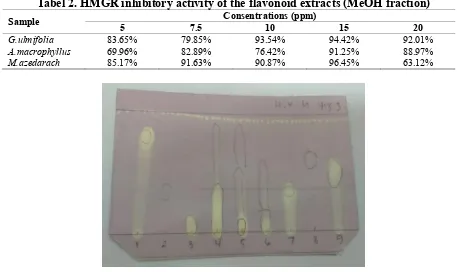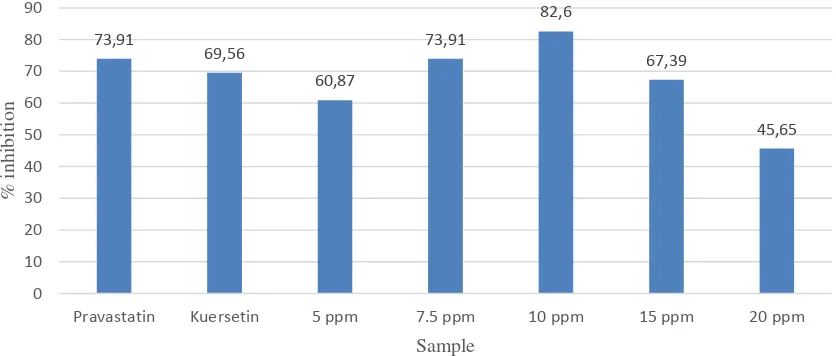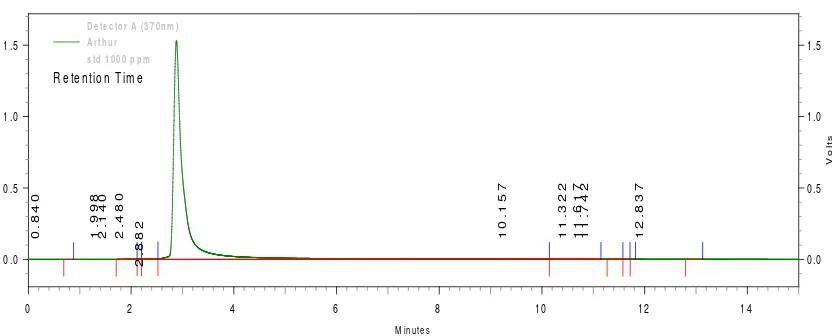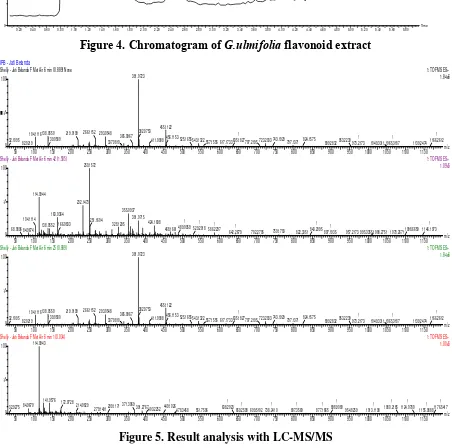95
Identification of HMG
-
CoA Reductase Inhibitor Active Compound
in Medicinal Forest Plants
Identifikasi Senyawa Aktif dari Tumbuhan Hutan Berkhasiat Obat
sebagai Inhibitor HMG-CoA Reductase
Shelly Rahmania1 *, Sulistiyani1, 2, Arthur A Lelono3
1
Departement of Biochemistry, Bogor Agricultural University, Bogor, Indonesia
2Biopharmaca Research Center, Bogor Agricultural University, Bogor, Indonesia 3Chemistry Research Center, The Indonesian Institute of Sciences, Tangerang, Indonesia
*E-mail: rahmaniashelly@gmail.com
Diterima: 28 Februari 2017 Direvisi: 28 Juli 2017 Disetujui: 31 Juli 2017
Abstract
Cardiovascular disease is a leading cause of death worldwide, hypercholesterolemia is one of the causes. Three medicinal forest plants are potential natural resources to be developed as cholesterol-reducing herbal product, but scientific informations on their mechanism is still limited. The objective of this research is to explore the potency of the leaf of Jati Belanda (Guazuma ulmifolia), Jabon (Antocephalus macrophyllus), and Mindi (Melia azedarach)
as inhibitor of HMG-CoA reductase (HMGR), a key enzyme in the regulation of cholesterol biosynthesis. Samples were macerated in ethanol 96% and the filtrate was partitioned using n-hexane and chloroform to obtain the ethanolic flavonoid extract. The effect of each extracts on the HMG-CoA reductase activity were analyzed using HMGR assay kit. At concentration of 10 ppm the G.ulmifolia ethanolic extract showed the highest inhibitory activity as well as pravastatin control inhibitor. The phenolic content of the ethanolic extracts of
G.ulmifolia, A.macrophyllus, and M.azedarach were: 11.00, 34.83, and 13.67 mg gallic acid AE/g dried leaves, respectively. The flavonoid content of the ethanolic extracts of G.ulmifolia, A.macrophyllus, and M.azedarach
were: 0.22, 0.64, and 0.78 mg QE/g dried leaves, respectively. Interestingly, G.ulmifolia extract the lowest concentration of phenolic and flavonoid content. HPLC analysis showed that all samples contain quercetin at similiar small concentrations (6.7%, 6.6%, and 7.0% for G.ulmifolia, A.macrophyllus, and M.azedarach, respectively). This indicating other active compounds may play some roles in this inhibitory action on HMG-CoA reductase activity. Further identification using LC-MS/MS showed that G.ulmifolia flavonoid extract contained an unidetified coumpound with molecural weight of 380.0723 Da.
Keywords: G. ulmifolia; A. macrophyllus; M.azedarach; HMG-CoA reductase inhibitor; in vitro assay
Abstrak
Penyakit kardiovaskular adalah penyebab utama kematian di dunia, kondisi hiperkolesterolemia (tingginya kolesterol darah) adalah salah satu penyebab dari penyakit kardiovaskular. Tiga tumbuhan hutan berkhasiat obat diketahui memiliki potensi untuk dikembangkan sebagai produk herbal penurun kolesterol, tetapi informasi ilmiah tentang mekanismenya masih terbatas. Tujuan dari penelitian ini adalah untuk mengeksplorasi potensi dari daun Jati Belanda (Guazuma ulmifolia), Jabon (Antocephalus macrophyllus), dan Mindi (Melia azedarach) sebagai inhibitor HMG-CoA reductase (HMGR), enzim kunci dalam regulasi biosintesis kolesterol. Sampel dimaserasi dalam etanol 96% dan filtrat dipartisi menggunakan n-heksana dan kloroform untuk mendapatkan ekstrak flavonoid etanol. Pengaruh setiap ekstrak pada aktivitas HMGR dianalisis menggunakan HMGR assay kit. Sampel G.ulmifolia pada konsentrasi 10 ppm menunjukkan daya inhibisi tertinggi (82.6% inhibisi). Total fenolik dari sampel G.ulmifolia, A.macrophyllus, dan M.azedarach berturut-turut adalah 11.00, 34.83, dan 13.67 mg asam galat/g kering. Total flavonoid dari sampel G.ulmifolia, A.macrophyllus, dan M.azedarach berturut-turut sebesar 0.22, 0.64, dan 0.78 mg kuersetin/g kering. Menariknya, sampel G.ulmifolia memiliki kadar terendah baik total fenolik maupun total flavonoidnya. Analisis HPLC menunjukkan bahwa semua sampel mengandung kuersetin pada konsentrasi rendah (6.7%, 6.6%, dan 7.0%; berturut-turut untuk G.ulmifolia, A.macrophyllus, dan M.azedarach). Hal ini menunjukkan ada senyawa aktif lainnya (selain kuersetin) yang mungkin memainkan beberapa peran dalam aksi penghambatan aktivitas HMGR. Identifikasi lebih lanjut dengan menggunakan LC-MS/MS menunjukkan bahwa sampel G.ulmifolia mengandung senyawa aktif lain dengan berat molekul 380.0723 Da.
Kata kunci: Jati belanda; jabon; mindi; inhibitor HMG-CoA reductase; asai in vitro
96
INTRODUCTION
Cardiovascular disease is a leading cause of death worldwide. About 17.5 million people die from cardiovascular disease in 2012 (WHO 2016).1 Riset kesehatan dasar (Riskesdas) from Ministry of Health of the Republic of Indonesia
In Indonesia, various medicinal plants have been used over many generations as traditional remedies for cardiovascular disorders. Unfortunately, only a few scientific studies have been conducted to explore the potential of some medicinal forest plants as cholesterol reducing natural product, particularly based on their mechanism of action.
Presently, the active component of the commercially available natural product for reducing blood cholesterol is statin, which acts as HMG-CoA reductase (HMG-CoA reductase is an oxydoreductase enzyme, so it is estimated that this enzyme can be inhibited by compounds that have antioxidant activity) inhibitor. When administered in long-term period, however, some side effects were reported such as nausea, diarrhea, constipation, and an increase of alanine transaminase (ALT ) dan aspartate transaminase (AST) of the liver.3 These side effects has prompted researchers to seek alternatives other than statin. Secondary metabolites that have been reported as HMG-CoA reductase inhibitors were alkaloids and flavonoids.4 Sungsuk et al reported cholesterol reducing activity by quercetin of plant forest Allium victorialis.5
Administration of Guazuma ulmifolia leaves extract mixture to hyperlipidemic rats has been reported to reduce the rats’ liver total cholesterol concentration6 as well as the lipid peroxide content.7 No reports
regarding the effect of Antocephalus macrophylus on cholesterol metabolism, only recent report by Cruz JP on the
antimicrobial activity of the alcoholic extract of the leaves.8 Others have reported
the antioxidant activity of its leaves and fruits.9 Similarly, methanolic leaf extract of Melia azedarach has been shown to posses antioxidant activity and the bark extract was shown to be highly bioactive with very small LC50 on BSLT assay. No reports was
found on the anticholesterol activity of M. azedarach.
Since scientific informations on medicinal plants of Indonesian forest that are potential or that has been used traditionally for therapy of cardiovascular disease is still limited, this study was carried out to explore the potency of jati belanda (G.ulmifolia), jabon merah (A.macrophyllus), and mindi (M.azedarach) leaves extracts as inhibitors of HMG-CoA reductase using in vitro assay and to identify the most active metabolite.
METHODS
Samples preparation
Dried leaves for this study has been prepared as reported by Sulistiyani et al.10
Sampling method was conducted using a Farmakope Herbal Indonesia procedure.11
Samples (Biopharmaca Research Center, Bogor, Indonesia) were dried at 50oC.
Then, dried leaves were mashed into 40 mesh.
Tools and materials
High performance liquid chromato -graphy (HPLC), liquid chromato-graphy -Mass spectrometry and tandem mass spectrometry (LC-MS/MS), methanol (Merck), ethanol (Merck), chloroform (Merck), standard gallic acid, standard quercetine , standard rutine, jati belanda(G. ulmifolia) leaf powder, jabon merah (A. macrophyllus) leaf powder, and mindi (M. azedarach) leaf powder from Biopharmaca Research Center, Bogor, Indonesia.
Flavonoid extraction
97 the extract was partitioned using n-hexane
(3x50 mL) that gave n-hexane fractions and residue. Then, the residue was fractioned with chloroform (3x50 mL) to obtain flavonoid extract.10
HMG-CoA reductase activity assay
The activity of the enzyme was analyzed using assay kit of HMGR from Sigma Aldrich with catalog number CS1090. This kit contains a buffer solution, NADPH as coenzyme, substrate solution (HMG-CoA), HMGR enzyme (EC 1.1.1.34, 0.5-0.7 mg/mL), and inhibitor solution (pravastatin). 1 mL of samples with various concentrations (5-20 ppm) were added into the microplate. For comparison, quercetine at 5 ppm was used. Aliquots of buffer solution were added until final volume of 200 µL. Subsequently, NADPH (4 µL), HMG Co-A (12 µL), and HMGR (2 µL) were added into wells of control enzyme, samples, inhibitory, and blanks, respectively. Inhibition of the enzyme activity was measured with a microplate Reader spectrophotometer every 20 seconds for 10 minutes at 37ºC and wavelength of 340 nm.12
Analysis of antioxidant activity
All samples and standard were spotted on thin layer chromatography (TLC) plates using silica gel as stationary phase and hexane: chloroform: methanol (4:3:3) as mobile phase. After fractions were developed, DPPH solution (4 mg/10 mL MeOH) was sprayed into TLC plates. A yellowish spots that appeared on the spot is an indication for antioxidant activity.13
Total phenolic content determination
The concentration of phenolics in plant extracts was determined using spectrophotometric method. The reaction mixtures was prepared by mixing 0.5 mL of sample, 2.5 mL of 10% Folin Ciocalteu reagent, and 2.5 mL of 7.5% Na2CO3 were
prepared. The samples were incubated in a waterbath at 450C for 45 minutes. The
absorbance was determined using
spectrophotometer at λmax=765 nm. Gallic
acid was used as the standard (one type of phenolic coumpond).14
Total flavonoid content determination
Sample mixtures which consisted of 0.2 gram extract, 1 mL heksametil- entetramin (HMT), 20 mL acetone, and 2 mL of HCl 25% were prepared and then these mixtures were refluxed for 30 minutes. Each mixture was filtered and acetone was added up to a volume of 100 ml using volumetric flask, after which it was poured into separation funnel wich has been filled with water in equal volume. This mixture was extracted with ethyl acetate (3 x 15 mL, and the ethyl actetate fraction was collected and made up to a volume of 50 mL. A total of 10 mL of this fraction was mixed with 1 mL of AlCl3
and the volume was added up to 25ml with acetic acid glacial, and was kept in room temperature for 30 minutes. The samples absorbance was read at 425 nm wavelength using quercetin as the standard.15
Concentration of quercetin analysis with high performance liquid chromato
-graphy (HPLC)
Quercetin content in the samples was analyzed quantitatively by reversed phase-high performance liquid chromatography (RP-HPLC). RP-HPLC analysis was performed by isocratic elution with a flow rate of 1.0 mL/min. Methanol was used as mobile phase. The injected volume of samples was 5 µL, while the detection wavelength was 370 nm. Standard quercetin was prepared in a various concentration series (5 concentrations).16
Analysis of marker compounds with
liquid chromatography -mass
spectrometry and tandem mass spectrometry (LC-MS/MS)
98
mobile phase. The injected volume of samples was 5 µL.17
RESULTS AND DISCUSSIONS
Flavonoids extract yield
Flavonoids were fractionated separately from the crude methanolic and ethanolic- extracts after partitioning the non-polar and semi-polar compounds with n-hexane and chloroform. The yields of six different ethanolic extract (18.32%). The highest yields were obtained from those fractionated from the methanolic extracts which suggested that the methanol extracted flavonoids compounds more than the ethanol. The flavonoid yields from the ethanolic extracts were consistenly lower than their crude extract yield as previously reported by Riki18 who reported the yield of the crude ethanolic leaf extracts of G. ulmifolia, A. macrophyllus, and M. azedarach were: 11.67%, 21.69%, and 26.96%, respectively.
Tabel 1 Recovery of flavonoid extracts
Sample % Recovery(MeOH fraction) and mevalonate, which is a highly regulated reaction in cholesterol biosynthesis. There were quite a number of works have been done in search of substances with inhibitory action against the HMGR activity. Their targets mostly were to discover HMG-CoA analogs and to seek out its competitive inhibitor of the enzyme19. Table 2 shows the
inhibitory activity of the methanolic
flavonoid fractions of several herbals in various concentrations against the HMGR (Table 2). All flavonoid extracts were shown to inhibit the HMGR (63.12-96.45%). Flavonoids leaf extracts of
G.ulmifolia, however, were the best HMGR inhibitor out of the three plants (79.85-94.42%) when compared to the other two extracts which showed lower inhibitory activity (~ 60%). This findings are consistent with the previous works by Sulistiyani et al.10 WHO reported that
methanolic flavonoid extracts of G. ulmifolia leaves at concentration of 20 ppm was able to inhibit the HMGR activity with the highest inhibitory activity compared to those of A.macrophyllus and M.azedarach.
In preparation for future product development, however, the use of ethanolic flavonoid extracts are preferable for further studies in order to follow the safety regulation by Indonesian Ministry of Health. Thus, to provide additional information regarding the flavonoids contained in the ethanolic extracts, qualitative DPPH test was carried out using catechin, naringin, and rutin as flavonoid standards; and 2,3-dihydroxy benzoic acid, 2,6-dihydroxy benzoic acid, and 3,6 -dihydroxy benzoic acid as phenolic standards. Figure 1 shows that the ethanolic flavonoid extract of G. ulmifolia was potent antioxidant compare to others. The presence of antioxidant compounds was detected by yellow spots against the purple background on TLC plates as described by Masoko & Eloff.20 Based on the standard,
there were various flavonoids in G.ulmifolia ethanolic extract, which include: rutin (a glycoside of a flavonol quercetin), catechin (a flavanol), naringin, as well as the phenols 2,3-dihydroxy benzoic acid and dan 3,6-dihydroxy benzoic acid. The other two extracts also contain antioxidant activity, only to a lesser degree. Based on this finding and other data, flavonoid of G. ulmifolia from ethanolic extract was selected for further study.
99 the flavonoid of G.ulmifolia ethanolic
extracts in various concentrations compared to pravastatin control and quercetin standard. In our system, the pravastatin control inhibited 73.91% of HMGR activity, while quercetin showed slightly less inhibitory activity (69.56%). Pravastatin is a commercially available derivate of statin, a compound known originally as the HMGR inhibitor. Statin inhibited HMGR due to its molecular similarity to mevalonate, which is the product of the enzyme reaction catalyzed by the enzyme. By way of feed-back inhibition mechanism, this enzyme inhibiton will result in the cholesterol synthesis being blocked. Statin competes with the substrate to occupy the active site of the HMGR and changes the conformation of the enzyme.
The inhibitory actions of the flavonoid extracts on HMGR activity was varied, ranging from 45.65% up to 82.8%. The extract with 10 ppm concentration showed
highest inhibitory activity, which is also higher than those of pravastatin control and quercetin. Interestingly, this inhibitory activity was lower when the extract concentration was increased to 20 ppm. This phenomenon could be due to component interaction since the samples were still a mixture of crude flavonoids which contain various type of flavonoids with different action. The HMGR inhibitory effect of flavonoids in this study is consistent with a previous study by Sungsuk et al.5. They reported that leaf
extract of Allium victorialis, a type of wild onions grown in the forest area, could inhibit HMGR activity by 73.9%. in this study, quercetin and kaempferol isolated from the plant extract were shown to inhibit the HMGR gene expression using reverse transcriptase-polymerase chain reaction (RT-PCR). It was concluded that both compounds inhibited the cholesterol biosynthesis at the mRNA level.
Tabel 2. HMGR inhibitory activity of the flavonoid extracts (MeOH fraction)
Sample 5 7.5 Consentrations (ppm)10 15 20
G.ulmifolia 83.65% 79.85% 93.54% 94.42% 92.01%
A.macrophyllus 69.96% 82.89% 76.42% 91.25% 88.97%
M.azedarach 85.17% 91.63% 90.87% 96.45% 63.12%
Figure 1. Antioxidant activity of flavonoid extracts (EtOH fraction) (1) catechin (2) naringin, (3) rutin, (4) G.ulmifolia, (5) A.macrophyllus, (6) M.azedarach, (7) 2,3-
100
Figure 2. Inhibitory action of the ethanolic flavonoid extracts of G. ulmifolia leaves against HMGR activity
Identification of active compounds Total phenolic and flavonoid contents
The total phenolic content of the samples was determined using gallic acid as the standard (standard curve equation: y = 0.0079x + 0.0125, r2 = 0.9997). The phenolic contents were ranging from 10.00 mg to 34.83 mg gallic acid equivalent/g dried leaves (Table 3) with the flavonoid extract of A. macrophyllus being the extract with the highest phenolic content, and the lowest content was that of G.ulmifolia. Total flavonoids of the plant ethanolic extracts was determined using quercetin as the standard (standard curve equation: y = 0.1004×-0.0065, r2=0.9997). The flavonoid
contents were ranging from 0.221 mg to 0.777 mg quercetin equivalent /g dried leaves (Table 4). Similar to phenolic data, G.ulmifolia had the lowest quercetin content. This observation was consistent with previous report by Sulistiyani et al.10 which showed that methanolic flavonoid extract of G.ulmifolia had the lowest quercetin content among those three samples. Thus, the inhibitory action of the extracts was not correlated with the quercetin content. Taken together, these data indicate that the HMG-CoA reductase inhibitory effect of G.ulmifolia may not be mainly due to the quercetin compound nor its glycoside.
Table 3 Total phenolic contents
Sample Absorbance Extract’s weights (mg)
Dried leaves’ weights (g)
Gallic Acid (mg GAE/L)
Total phenolic (mg GAE/g dried
leaves)
G.ulmifolia 0.190 ± 0.009 2.5 0.001123 22.47 10.00 ± 0.534
A.macrophyllus 0.403 ± 0.003 2.6 0.000709 49.43 34.83 ± 0.272
M.azedarach 0.163 ± 0.013 2.6 0.000697 19.05 13.67 ± 1.156
Table 4 Total flavonoid contents
Sample Absorbance Extract’s weights (mg)
Dry leaves’
weights (g) (mg QE/L)Quercetin
Total flavonoid (mg QE/g dried
leaves)
G.ulmifolia 0.043 ± 0 0.1548 1.391 0.49 0.22 ± 0
A.macrophyllus 0.081 ± 0.003 0.1906 0.850 0.87 0.64 ± 0.025
M.azedarach 0.121 ± 0.001 0.1558 1.022 1.27 0.78 ± 0.006
73,91
69,56
60,87
73,91
82,6
67,39
45,65
0 10 20 30 40 50 60 70 80 90
Pravastatin Kuersetin 5 ppm 7.5 ppm 10 ppm 15 ppm 20 ppm
% in
h
ib
itio
n
101
HPLC analysis of the flavonoid extracts
The RP-HPLC was carried out using nonpolar immobile phase (C18 column) and polar (MeOH) mobile phase and quercetin as the standard. The quercetin detection wavelength was 370 nm. The retention time for quercetin standard (1000 ppm) was 2.882 minutes (Figure 3).The concentrations of quercetin in the ethanolic flavonoid extracts were calculated using the peak area in the similar retention time as shown in Table 5. The amount of quercetin in the three extracts (1000 ppm) were ranging from 65.99 ppm to 70.41 ppm indicating that quercetin may not be the major active compound responsible for the HMG-CoA inhibitory action in G.ulmifolia flavonoid extract. The small amount of quercetin in the ethanolic extracts of flavonoid is accountable for since most of the nonpolar flavonoids was already removed during the extraction process.
There is a possibility that rutin, the polar glycoside form of quercetin, might be the active component in the ethanolic flavonoid extract; the answer to which will await further investigation.
Identification of active component with LC-MS/MS.
Analysis of LC-MS /MS chromatogram shows that the sample demonstrated more than one peak (Figure 4). Further analysis showed that the extract contained several compounds, but the largest one in the sample has a molecular weight of 380.0723 Da (Figure 5). This method of identification, however, was showing only the weight and possible formula, and was not able to predict the exact active compound. Further analysis of the compound need to be done using NMR instrument in the future.
Table 5 Quercetin content of the ethanolic extracts.
Flavonoid Extracts Area Quercetin content (%)
G.ulmifolia (1000 ppm) 37248 6.7
M.azedarach (1000 ppm) 109550 7.0
A.macrophyllus (1000 ppm) 13857 6.6
102
Figure 4. Chromatogram of G.ulmifolia flavonoid extract
Figure 5. Result analysis with LC-MS/MS
IPB - Jati Belanda
Time
0.20 0.40 0.60 0.80 1.00 1.20 1.40 1.60 1.80 2.00 2.20 2.40 2.60 2.80 3.00 3.20 3.40 3.60 3.80 4.00 4.20 4.40 4.60 4.80 5.00 5.20 5.40 5.60 5.80
%
50 100 150 200 250 300 350 400 450 500 550 600 650 700 750 800 850 900 950 1000 1050 1100 1150
%
0 100
m/z
50 100 150 200 250 300 350 400 450 500 550 600 650 700 750 800 850 900 950 1000 1050 1100 1150
%
0 100
m/z
50 100 150 200 250 300 350 400 450 500 550 600 650 700 750 800 850 900 950 1000 1050 1100 1150
%
0 100
m/z
50 100 150 200 250 300 350 400 450 500 550 600 650 700 750 800 850 900 950 1000 1050 1100 1150
%
411.0908456.1153 525.1655543.1322557.1555617.1733 707.2195723.2033 !
635.1827 743.1929797.1371 824.1575 !
1065.3187
897.1935 995.33551008.27511078.26711098.6659 !
411.0908456.1153 525.1655543.1322557.1555617.1733 707.2195723.2033 !
635.1827 743.1929797.1371 824.1575 !
1065.3187
279.1491299.1171 403.2252 807.3569!
103
CONCLUSION
Methanolic flavonoid extract of G.ulmifolia showed the best potency as inhibitor of HMG-CoA reductase compared to those of A.macrophyllus and M. azedarach. For product development purpose, however, the ethanolic flavonoid extract of G. ulmifolia was selected for further analyses. This ethanolic flavonoid extract of G.ulmifolia was shown to contain more potent antioxidant activity than the 2 other extracts. The in vitro assay data consistently showed that this extract has the ability as HMGR inhibitor as well as pravastatin at concentration of 10 ppm (82.6%). HPLC analysis showed that all samples contain quercetin at similiar small concentrations (6.7%, 6.6%, and 7.0% for G. ulmifolia, A. macrophyllus, and M. azedarach, respectively). Thus indicating other active compounds may play some roles in this inhibitory action on HMG-CoA reductase activity. Further identification using LC-MS/MS showed that G. ulmifolia flavonoid extract contained an unidetified coumpound with molecural weight of 380.0723 Da.
ACKNOWLEDGMENTS
This works was partly granted by the Indonesian Ministry of Research, Technology and Higher Education through the Strategic Applied Research Funding 2016. The excellent analytical support was kindly provided by Research Center for Chemistry-Indonesia Institute of Science (LIPI).
REFERENCES
1. Cardiovascular Diseases (CVDs). Geneva (CH): World Health Organization; 2016. 2. Riset Kesehatan Dasar (Riskesdas).
Jakarta (ID): Kementrian Kesehatan Republik Indonesia; 2013.
3. Sullivan SO. Statins: A review of benefits and risks. TSMJ. 2007; (8):52-56.
4. Goncalves. Produtos naturais inibidores da enzima HMG-CoA reductase. Publicado na Revista Brasileira de Farmacia. 2000; (81):63-71.
5. Lee SS, Moon SH, Lee HJ, Choi DH, Cho MH. Cholesterol inhibitory activities of kaempferol and quercetin isolated from Allium victorialis var. platyphyllum. Journal of the Korean Wood Science and Technology. 2004;32(1):17-27.
6. Rahayu YS. Khasiat ekstrak ramuan daun jati belanda terhadap konsentrasi kolesterol hati tikus yang hiperlipidemia [skripsi]. Bogor. Fakultas Matematika dan Ilmu Pengetahuan Alam. Institut Pertanian Bogor; 2007.
7. Alviani. Khasiat ramuan ekstrak daun jati belanda terhadap peroksidasi lipid hati tikus yang hiperlipidemia [skripsi]. Bogor. Fakultas Matematika dan Ilmu Pengetahuan Alam. Institut Pertanian Bogor; 2007.
8. Cruz JP, Jubilo RMM. Evaluation of the anti-staphylococcal activity of Nauclea
orientalis Linn. European Scientific
Journal. 2014 Sept;(27):170-179.
9. Thusyanthan J, Soysa P, Sivakanesan R. Antioxidant activity of some selected medicinal plants of family rubiaceae and acanthaceae using 1,1-Diphenyl- 2-Picrylhydrazyl (DPPH) Assay. Proceedings of the Peradeniya Univ. International Research Sessions. 2014 ;18: 363.
10. Sulistiyani, Sari RK, Wahyuni WT. Pengembangan produk antikolesterol dari tumbuhan hutan berbasis mekanisme penghambatan enzim HMG-KoA reduktase. Laporan Akhir Tahun Penelitian Desentralisasi Baru IPB 2014.
11. Indonesia. Departemen Kesehatan Republik Indonesia. Farmakope Herbal Indonesia. Jakarta: Depkes RI; 2008. 12. Perchellet JP, Perchellet EM, Crow KR,
Buszek KR, Brown N, Ellappan S, Gao GE, Luo D, Minatoya M, Lushington GH. Novel synthetic inhibitors of 3-hydroxy-3-methylglutaryl-coenzyme A (HMG-CoA) reductase activity that inhibit tumor cell proliferation and are structurally unrelated to existing statins. International journal of molecular medicine. 2009 Nov 1;24(5):633-43. 13. Chacha M, Gojase-Moletta G, Majinda
RRT. Antimicrobial and radical scavenging flavonoids from the stem wood of Erithrina latissima. Phythochemistry. 2005;66:99-104.
104
M, Solujic S. Total phenolic content, flavonoid concentrations and antioxidant activity, of the whole plant and plant parts extracts from Teucrium montanum L. var. montanum, F. supinum (L.) Reichenb. Biotechnology & Biotechnological Equipment. 2011 Jan 1;25(1):2222-7. 15. Indonesia. Badan Pengawas Obat dan
Makanan, Republik Indonesia. Monografi Ekstrak Tumbuhan Obat Indonesia. Jakarta: BPOM RI; 2004
16. Savic IM, Nikolic VD, Savic IM, Nikolic LB, Stankovic MZ. Development and validation of a new RP-HPLC method for determination of quercetin in green tea. Journal of analytical chemistry. 2013 Oct 1;68(10):906-11.
17. Chen HJ, Inbaraj BS, Chen BH. Determination of phenolic acids and
flavonoids in Taraxacum formosanum kitam by Liquid Chromatography tandem mass spectrometry coupled with a post-column derivatization technique. Int. J. Mol. Sci. 2012;13:260-285.
18. Purnama RL. Aktivitas aktioksidan, kandungan total fenol, dan flavonoid lima tanaman hutan yang berpotensi sebagai obat alami. [skripsi]. Bogor. Fakultas Matematika dan Ilmu Pengetahuan Alam. Institut Pertanian Bogor; 2015.
19. Harvey RA, Ferrier DR. Lippincott’s Illustrated reviews: Biochemistry 5th ed.
Philadelphia: Wolters Kluwer; 2011. 20. Masoko P, Eloff JN. Screening of 24 South



